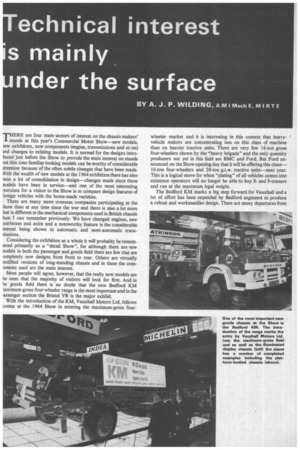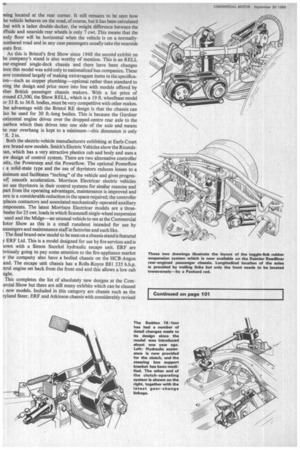echnical interest s mainly nder the surface
Page 96

Page 97

Page 98

If you've noticed an error in this article please click here to report it so we can fix it.
THERE are four main sectors of interest on the chassis makers' stands at this year's Commercial Motor Show—new models, lew exhibitors, new components (engine, transmissions and so on) it'd changes to existing models. It is normal for the designs introluced just before the Show to provide the main interest on stands )ut this time familiar-looking models can be worthy of considerable ittention because of the often subtle changes that have been made. With the wealth of new models at the 1964 exhibition there has also nen a lot of consolidation in design—changes made since these nodels have been in service—and one of the most interesting :xercises for a visitor to the Show is to compare design features of breign vehicles with the home-made varieties.
There are many more overseas companies participating at the ;how than at any time since the war and there is also a lot more hat is different in the mechanical components used in British chassis han I can remember previously. We have changed engines, new ;earboxes and axles and a noteworthy feature is the considerable aterest being shown in automatic and semi-automatic transnissions.
Considering the exhibition as a whole it will probably be rememered primarily as a "detail Show", for although there are new nodels in both the passenger and goods field there are few that are ompletely new designs from front to rear. Others are virtually acidified versions of long-standing chassis and in these the comionents used are the main interest.
Most people will agree, however, that the really new models are he ones that the majority of visitors will look for first. And in he goods field there is no doubt that the new Bedford KM aaximum-gross four-wheeler range is the most important and in the assenger section the Bristol VR is the major exhibit.
With the introduction of the KM, Vauxhall Motors Ltd. follows tootes at the 1964 Show in entering the maximum-gross four wheeler market and it is interesting in this context that heavyvehicle makers are concentrating less on this class of machine than on heavier tractive units. There are very few 16-ton gross four-wheelers shown by the "heavy brigade" and the only quantity producers not yet in this field are BMC and Ford. But Ford announced on the Show opening day that it will be offering this class16-ton four-wheelers and 28-ton g.t.w. tractive units—next year. This is a logical move for when "plating" of all vehicles comes into existence operators will no longer be able to buy 8and 9-tonners and run at the maximum legal weight.
The Bedford KM marks a big step forward for Vauxhall and a lot of effort has been expended by Bedford engineers to produce a robust and workmanlike design. There are many departures from previous Bedford practice including such things as detachable drums, three-piece 10-stud wheels and the use of power-assisted steering as standard. The new engine used in the KM also looks to be of a high quality and, in fact, every part of the chassis warrants favourable comment.
By placing the engine at the rear offside corner of the VR chassis, Bristol Commercial Vehicles give the greatest freedom possible to bodybuilders and operators in the location of entrances and exits. Front or rear staircases are possible with the design and the offering of two wheelbases allows for bodies 33 ft. or 36 ft. long. At first sight people may think that there must be some problems with weight distribution with the Gardner 6LX engine and semiautomatic transmission unit weighing together about 1.25 cwt. oeing located at the rear corner. It still remains to be seen how he vehicle behaves on the road, of course, but it has been calculated hat with a laden double-decker, the weight difference between the )ffside and nearside rear wheels is only 7 cwt. This means that the )ody floor will be horizontal when the vehicle is on a normallymmbered road and in any case passengers usually take the nearside ;eats first.
As this is Bristol's first Show since 1948 the second exhibit on he company's stand is also worthy of mention. This is an RELL ear-engined single-deck chassis and there have been changes ince this model was sold only to nationalized bus companies. These lave consisted largely of making extravagant items in the specificaion—such as copper plumbing—optional rather than standard to iring the design and price more into line with models offered by ither British passenger chassis makers. With a list price of iround £3,300, the Show RELL, which is a 19 ft. wheelbase model or 33 ft. to 36 ft. bodies, must be very competitive with other makes. The advantage with the Bristol RE design is that the chassis can lso be used for 30 ft.-long bodies. This is because the Gardner lorizontal engine drives over the dropped-centre rear axle to the earbox which then drives into one side of the axle and means he rear overhang is kept to a minimum—this dimension is only 'ft. 2 in.
Both the electric-vehicle manufacturers exhibiting at Earls Court ave brand-new models. Smith's Electric Vehicles show the Roundstan, which has a very attractive plastics cab and body and uses a ew design of control system. There are two alternative controller nits, the Powerstep and the Powerflow. The optional Powerflow 3 a solid-state type and the use of thyristors reduces losses to a inimum and facilitates "inching" of the vehicle and gives progresvd: smooth acceleration. Morrison Electricar electric vehicles ;so use thyristors in their control systems for similar reasons and part from the operating advantages, maintenance is improved and tere is a considerable reduction in the space required; the controller ;places contactors and associated mechanically-operated auxiliary omponents. The latest Morrison Electricar models are a three'heeler for 25 cwt. loads in which Scammell single-wheel suspension used and the Midge—an unusual vehicle to see at the Commercial lotor Show as this is a small runabout intended for use by tessengers and maintenance staff in factories and such like.
The final brand-new model to be seenon a chassis stand is featured y ERF Ltd. This is a model designed for use by fire services and is town with a Simon Snorkel hydraulic escape unit. ERF are loviously going to pay some attention to the fire-appliance market 'r the company also have a bodied chassis on the HCB-Angus and. The escape unit chassis has a Rolls-Royce B81 235 b.h.p. ttrol engine set back from the front end and this allows a low cab This completes the list of absolutely new designs at the Comercial Show but there are still many exhibits which can be classed ; new models. Included in this category are chassis such as the eyland Steer, ERF and Atkinson chassis with considerably revised
















































































































































































































